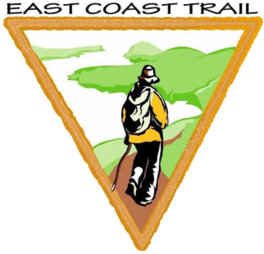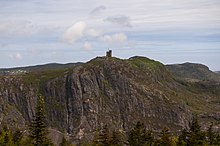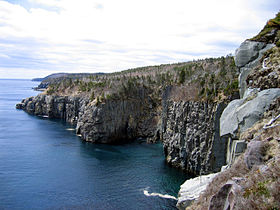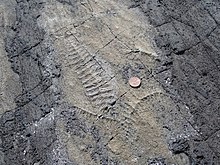East Coast Trail: Difference between revisions
→Transportation: More information added |
|||
| Line 289: | Line 289: | ||
==Transportation== |
==Transportation== |
||
Buses can be used to access [[Logy Bay]], including road walk; [[Quidi Vidi]]; [[Fort Amherst]] with road walk; [[Shea Heights]] for Deadman's Bay and Freshwater; Shoal Bay Road.<ref>[https://www.metrobus.com/html-default/bootstrap/pages/index.asp Metrobus]</ref> There is a minibus taxi |
Buses can be used to access [[Logy Bay]], including road walk; [[Quidi Vidi]]; [[Fort Amherst]] with road walk; [[Shea Heights]] for Deadman's Bay and Freshwater; Shoal Bay Road.<ref>[https://www.metrobus.com/html-default/bootstrap/pages/index.asp Metrobus]</ref> There is a minibus taxi services to and from Treppassey;<ref>[https://www.newfoundlandlabrador.com/plan-and-book/transportation-and-information?ContactTypeIDs=14268 Local Transportation, The Government of Newfoundland]</ref><ref>[https://www.ectthruhike.com the ECTThruhike page also has more information re other operators]</ref> |
||
Cape Spear (seasonal bus – frequent service).<ref>[https://stjohnshoponhopoff.ca |
Cape Spear (seasonal bus – frequent service).<ref>[https://stjohnshoponhopoff.ca Hop on Hop Off]</ref> |
||
==See also== |
==See also== |
||
Revision as of 20:46, 2 April 2020
| East Coast Trail | |
|---|---|
 | |
| Length | 540 km (340 mi) |
| Location | Newfoundland, Canada |
| Trailheads | Near St. John's; Cappahayden |
| Use | Hiking |
| Difficulty | Easy to Strenuous |
| Season | Year Round |
The East Coast Trail (ECT) is a long-distance coastal footpath located in the Canadian province of Newfoundland and Labrador. It is a developed trail over 300 kilometres (190 mi) long, creation of which began in 1994. It is made up of 26 linked wilderness paths and passes through more than 30 communities.[1] It was named one of the best adventure destinations by National Geographic in 2012 and is extended and improved yearly.[2]
Maintained by the East Coast Trail Association and located primarily on public lands, the trail follows the east coast of Newfoundland along the Atlantic Ocean. The path passes through many small coastal outports (villages) in the bays of the Avalon Peninsula. The trail runs from Topsail Beach, north to Cape St. Francis, then south through St. John's, and continues south as far as Cappahayden.[1] It is intended that the trail will eventually be extended to Trepassey in the south and across to Placentia in the west (from Ferryland).[3]
The trail also passes several National historic sites, including Signal Hill, St. John's, Cape Spear, the easternmost point in North America (ignoring Greenland), and Ferryland, the site of the 17th-century Colony of Avalon. It also passes through La Manche and Chance Cove Provincial Parks. There are seasonal views of icebergs, birds, whales, other marine and plant life, and eight historic lighthouses along the path. The individual sections of the trail range in hiking time from a few hours to a full day; there are some designated camping spots along the trail, though most walkers use local accommodation.[1]



History
The Trail officially began in 1994 "when a group of hiking enthusiasts started the construction of a coastal trail" that would make use of existing traditional trails that linked local communities along the coast of the Avalon Peninsula. The following year the East Coat Trail Association was incorporated and it was subsequently was registered aa charity. The initial plan "was to build and maintain" a long distance coastal footpath from Topsail Beach to Trepassey and in 1997 the Association obtained funds from the Federal Government to develop this 220 km trail. In 2001 this trail was officially opened.[4] Subsequently, the route has been extended from St. John's, with the last section between Topsail Beach and Portugal Cove, now walkable and due for final upgrading this summer.[5]
The final goal is "540 km of coastal and inland trail", which will include the completion of the trail between Capperhayden and Treppassey, and side trails from Ferryland, namely the 90 kilometres D'Iberville Trail, crossing the Avalon Wilderness Reserve from Ferryland to Placentia, connecting Lord Baltimore's Colony of Avalon to Castle Hill, Placentia and the 30 kilometres Masterless Men Path, an inland route stretching all the way to the Butterpot, linking Ferryland and Renews.[6][7]
The D'Iberville Trail is named after the French explorer and soldier Pierre Le Moyne d'Iberville. The Masterless Men trail takes its name from "a legendary outlaw society (fl late 18th, early 19th centuries ... [of] men escaping press gangs, Royal Navy deserters and runaway indentured servants from Newfoundland fishing plantations who fled inland to escape their harsh life. ... said to have inhabited the wild Butter Pot barrens of the Avalon Peninsula.[8]
Climate
| Climate data for Logy Bay-Middle Cove-Outer Cove | |||||||||||||
|---|---|---|---|---|---|---|---|---|---|---|---|---|---|
| Month | Jan | Feb | Mar | Apr | May | Jun | Jul | Aug | Sep | Oct | Nov | Dec | Year |
| Record high °C (°F) | 16.0 (60.8) |
16.0 (60.8) |
15.0 (59.0) |
24.0 (75.2) |
26.7 (80.1) |
30.0 (86.0) |
30.0 (86.0) |
31.0 (87.8) |
30.0 (86.0) |
24.0 (75.2) |
25.0 (77.0) |
15.0 (59.0) |
31.0 (87.8) |
| Mean daily maximum °C (°F) | 0.3 (32.5) |
0.0 (32.0) |
2.1 (35.8) |
6.0 (42.8) |
11.0 (51.8) |
15.7 (60.3) |
20.4 (68.7) |
20.7 (69.3) |
16.9 (62.4) |
11.4 (52.5) |
7.0 (44.6) |
2.6 (36.7) |
9.5 (49.1) |
| Daily mean °C (°F) | −3.6 (25.5) |
−4.0 (24.8) |
−1.5 (29.3) |
2.4 (36.3) |
6.6 (43.9) |
10.8 (51.4) |
15.6 (60.1) |
16.3 (61.3) |
12.8 (55.0) |
7.9 (46.2) |
3.7 (38.7) |
−0.9 (30.4) |
5.5 (41.9) |
| Mean daily minimum °C (°F) | −7.4 (18.7) |
−8.0 (17.6) |
−5.1 (22.8) |
−1.3 (29.7) |
2.2 (36.0) |
6.0 (42.8) |
10.7 (51.3) |
11.9 (53.4) |
8.6 (47.5) |
4.3 (39.7) |
0.3 (32.5) |
−4.3 (24.3) |
1.5 (34.7) |
| Record low °C (°F) | −24.4 (−11.9) |
−25.0 (−13.0) |
−23.3 (−9.9) |
−14.0 (6.8) |
−7.0 (19.4) |
−3.3 (26.1) |
−1.1 (30.0) |
3.5 (38.3) |
−1.1 (30.0) |
−8.0 (17.6) |
−13.0 (8.6) |
−25.0 (−13.0) |
−25.0 (−13.0) |
| Average precipitation mm (inches) | 122.5 (4.82) |
113.6 (4.47) |
102.9 (4.05) |
99.8 (3.93) |
83.2 (3.28) |
94.7 (3.73) |
86.8 (3.42) |
94.4 (3.72) |
121.1 (4.77) |
134.6 (5.30) |
126.0 (4.96) |
128.7 (5.07) |
1,308.1 (51.50) |
| Average rainfall mm (inches) | 72.9 (2.87) |
68.6 (2.70) |
77.6 (3.06) |
89.9 (3.54) |
81.4 (3.20) |
94.7 (3.73) |
86.8 (3.42) |
94.4 (3.72) |
121.1 (4.77) |
134.1 (5.28) |
116.7 (4.59) |
96.5 (3.80) |
1,134.6 (44.67) |
| Average snowfall cm (inches) | 49.6 (19.5) |
45.0 (17.7) |
25.3 (10.0) |
9.9 (3.9) |
1.8 (0.7) |
0.0 (0.0) |
0.0 (0.0) |
0.0 (0.0) |
0.0 (0.0) |
0.4 (0.2) |
9.3 (3.7) |
32.2 (12.7) |
173.6 (68.3) |
| Source: Environment Canada[9] | |||||||||||||
Route
All timings are for a one-way hike.
Tosail Beach to St John's
The trail runs mainly along the southern coast of the Avalon Peninsula, but initially, as far as Cape St. Francis, the direction is northerly.
Long Shore Path (Topsail Beach - Portugal Cove) A 17.2-kilometre (10.7 mi) moderate to difficult path that takes 6 to 8 hours. This path has been opened and is scheduled for completion by August 2020. It passes through St. Thomas, St. Philips, and Beachy Cove. Regular ferry service to Bell Island from Portugal Cove.
Piccos Ridge Path (Portugal Cove - Bauline) A 14.5-kilometre (9.0 mi) strenuous hike on high, open ground, of 7–8 hours. This path is considered undeveloped with minimal structures. The path has been cut and signed. There are long stretches of exposed trail so caution is advised. Exercise caution in all areas, especially on the steep north slope of Black Cliff.

White Horse Path 18.2 km (Bauline - Cape St. Francis) A 17.5-kilometre (10.9 mi) strenuous hike, 8–10 hours. This is still an undeveloped path with steep ascents and descents and wetland crossings, so caution is advised. Wilderness Patch Brook campsite.
Biscan Cove Path (Cape St. Francis - Pouch Cove) A 7.3-kilometre (4.5 mi) hike, of moderate difficulty, about 2–4 hours. The route can be challenging with steep hills.

Stiles Cove Path (Pouch Cove - Flatrock) A 15.1-kilometre (9.4 mi) hike of moderate difficulty. It takes 5–7 hours to complete. There are various access point. Swimming and picnic areas. [10]
Father Troy's Trail (Flatrock - Torbay) An 8.7-kilometre (5.4 mi) easy hike, 2–4 hours. It features a stony beach, Tappers Cove wharf and mural and the Beamer, a rock formation. There is a less difficult inland alternatives at Church Cove.[11]
Silver Mine Head Path 3.8-kilometre (2.4 mi) (Torbay - Outer Cove)
A 2.4-kilometre (1.5 mi) easy hike, of 1–2 hours. Features Middle Cove beach park and views to Torbay point and Flatrock. [12]
Cobblers Path (Outer Cove to Logy Bay)
A 8.2-kilometre (5.1 mi) hike of moderate difficulty, that takes 3–4 hours. It is a popular, partially boarded hike that features "The Cobbler" (a five finger-like rock formation), the remains of a Pinetree Line radar station and seasonal whale watching.[13]
Sugarloaf Path (Logy Bay - Quidi Vidi Village) A 8.9-kilometre (5.5 mi) hike that is at times difficult and takes 3–5 hours. It has various terrain and features Sugarloaf Head and rock formations. It also has a view of St. John's and Quidi Vidi. [14]

City of St. John's: Quidi Vidi to Fort Amherst
The official ECT map shows a route through St John's via Cuckold's Cove, Cabot Tower, Signal Hill and The North Head Trail to The Battery. In addition The Grand Concourse Trailway system offers a choice of possible routes to Downtown St John's.[15] From St John's to Fort Amherst, the ECT map again offers guidance. The route goes around the harbour, with a short-cut across a bridge across from the Railway Coastal Museum.[16] Amongst the attraction's found in St Joh's are boat trips to view icebergs, and whales; The Rooms; Quidi Vidi Lake; Memorial University's Botanical Garden; the Johnson Geo Centre, a geological interpretation centre located on Signal Hill; historic Downtown, including the Basilica, St John's and Anglican Cathedral, St John's. There is also the Grand Concourse's extensive network of hiking trails within the city, and around its lakes, along its rivers, and through other open spaces.
St John's to La Manche
The road connecting the settlements running south from St. John's – Route 10 – is known as the Irish Loop, because the communities were mainly sealed by Irish immigrants.[17]
Deadmans Bay Path (Fort Amherst - Blackhead)
A 10.6-kilometre (6.6 mi) moderate to difficult route that takes 5–8 hours. There are path features side trails that can increase distance and time. There are steep ascents and descents. The route passes the Fort Amherst lighthouse, the former settlement of Freshwater, and a barachois with remains of the Vasco d'Orey shipwreck. The Nature Conservancy of Canada has a reserve at Freshwater.[18] There are also seasonal swimming holes, berry grounds and bird nesting views.[19] There are side trails to this path from Shea Heights and the Cape Spear Road.[20]
Cape Spear Path (Blackhead - Maddox Cove)
A 9.3-kilometre (5.8 mi) path of moderate difficulty that takes 4–6 hours. The trail includes side trails. The path varies in terrain and features a nature conservancy area, Cape Spear National Historic Site, a lighthouse, a museum, picnic spot, seasonal berry grounds, and whale watching.[21] (See also the Blackhead Path a 3.7-kilometre (2.3 mi) path between the small community of Blackhead and Cape Spear, that is easy to moderate in difficulty. It takes 1–2 hours to complete. The path is very exposed to the weather so caution is advised. Cabot Tower can be seen across the sea and the path ends at Cape Spear National Historic Site with its historic lighthouse).

Motion Path (Petty Harbour - Shoal Bay Road)
Walk through the two communities to the start in Petty Harbour. A 13.5-kilometre (8.4 mi) that is moderate to difficult. It takes 7–9 hours. There are steep ascents and descents to Motion Head and Petty Harbour. A 6.3-kilometre (3.9 mi) access path along Shoal Bay Road from the highway.[22]
Spout Path (Shoal Bay Road - Bay Bulls) A 16.3-kilometre (10.1 mi) long and hilly path that is difficult to strenuous. It takes 5–8 hours (one way) to complete. The path passes the Spout, historic lighthouses, waterfalls, sea cliffs and sea stacks. There is also the possibility of seeing bald eagles nesting.[23] The trail can be accessed via Shoal Road (6.4-kilometre (4.0 mi)) from the highway.
Mickeleens Path (Bay Bulls - Witless Bay)
A 7.3-kilometre (4.5 mi) walk of easy to moderate difficulty that takes 2–4 hours. The terrain varies from woods, meadows and cliffs. The islands of the Witless Bay Ecological Reserve, can be seen, and there red sandstone cliffs, and views of coves, sea stacks, gulches. [24] In season there are boat trips from Witless Bay and Bay Bulls to view icebergs, whales, and the seabird colonies on the island's offshore.[25]

Beaches Path 7.1 km (Witless Bay - Mobile) An easy 7.0-kilometre (4.3 mi) hike, taking 2–3 hours. It is a shoreline walk with mild elevation changes and there are a picnic area, and Mobile Beach. Witless Bay Ecological Reserve lies offshore.[26]
Tinkers Point Path 5.0 km (Mobile - Tors Cove)
A 5.1-kilometre (3.2 mi) easy hike that takes 2–3 hours. There is beach access, picnicking, and seasonal bird and whale watching. [27]
La Manche Village Path (Tors Cove - La Manche, Newfoundland and Labrador Village)
A 6.4-kilometre (4.0 mi), easy hike that takes 2–3 hours. It is a relatively flat path though the woods that passes through La Manche Provincial Park, 50-metre (160 ft) across a suspension bridge and, offshore, the islands of the Witless Bay Ecological Reserve can be seen. The Reserve contains North America´s largest Atlantic puffin colony. and the world's second-largest colony of Leach's storm-petrels. 1.4-kilometre (0.87 mi) access trail from the highway.[22]
La Manche to Capperhayden

Flamber Head Path (La Manche Village - Brigus South)
A 11.5-kilometre (7.1 mi), moderate to difficult route that takes 6–9 hours. The wooded path passes through the resettled village of La Manche. There is waterfalls and wilderness camping and seabird and seasonal whale watching.[28] A 1.4-kilometre (0.87 mi) access trail from the highway.
Brigus Head Path (Brigus South - Admirals Cove) This 6.5-kilometre (4.0 mi) route is of moderate difficulty and takes 2–4 hours. It features Hares Ears rock formation at Hares Ears Point.[29]
Cape Broyle Head Path 19.4 km (Cape Broyle - Calvert) A 18.3-kilometre (11.4 mi) long route that is difficult to strenuous and takes 6–8 hours. A hilly hike has stream crossings. It features a sandy beach, twisted rock formation, campsite and views of Ferryland's lighthouse.[30]
Caplin Bay Path 5.6 km (Calvert - Ferryland) A 5.2-kilometre (3.2 mi) easy hike of 2–3 hours. A wooded walk with meadows and a section of elevated, old railroad track, and beaches and ocean views. There are side trails to Ferryland harbour and lighthouse.

Sounding Hills Path (Ferryland - Aquaforte) CLOSED
This is a 5.5-kilometre (3.4 mi) hike of easy to moderate difficulty. It takes 2–4 hours. The path goes through woods and along a stretch of Spout River. It passes close to the Colony of Avalon, National Historic archaeological site and interpretation centre, an old stone church, museum, tea room and dinner theatre.[31]
Mudder Wet Path (South West River – Aquaforte)
A 2.9-kilometre (1.8 mi) easy hike that takes 1–2 hours, It is a peaceful walk through the woods with views of tidal estuaries and waterfalls. [32]
Spurwink Island Path 20.4 km (Aquaforte - Port Kirwan)
This a 17.1-kilometre (10.6 mi) long challenging hike that takes 7–9 hours. There are views of Ferryland lighthouse, Berry Head sea arch and there is a wilderness campsite on the path.[33]
Bear Cove Path 11.9-kilometre (7.4 mi) Kingman's Cove and Renews)
A 11.6-kilometre (7.2 mi) hike of moderate difficulty. It takes about 4–6 hours. There are two historic sites, a settlement, lighthouse, and seasonal berry grounds. [34]
Island Meadow Path (Renews - Cappahayden) A 10.1-kilometre (6.3 mi) hike of moderate difficulty that takes 4–6 hours, that is primarily made up of woodlands and headlands, and there are views of Renews Island.[35]
Capperhayden to Trepassey
Not yet developed

Capperhayden to Trepassey via Chance Cove, Cape Race Lighthouse, Portugal Cove South and Mistaken Point Ecological Reserve.
Capperhayden to Chance Cove Provincial Park is undeveloped, and includes gravel road, rough trail, moose path, bush-wacking, trackless bog, and deep river crossings.[36] Chance Cove Provincial Park is a provincial park located approximately 20.0-kilometre (12.4 mi) south of Renews-Cappahayden. Chance Cove was once the site of a small settlement of approximately 50 people in the mid-19th century, and is home to many shipwrecks of the Atlantic Ocean.
Chance Cove to Cape Race is another difficult undeveloped, unmarked route, especially the middle section.[37]
Cape Race to Trepassey. There is a a 32.75-kilometre (20.35 mi) road between Cape Race, Portugal Cove South, and Trepassey[38] that passes Mistaken Point Ecological Reserve a wilderness area and a UNESCO World Heritage Site. The reserve is home to the Mistaken Point Formation, which contains one of the most diverse and well-preserved collections of Precambrian fossils in the world. Ediacaran fossils discovered at the site constitute the oldest known remnants of multicellular life on Earth.[39]
Portugal Cove South is 19-kilometre (12 mi) from Cape Race.
Accomodation
There are primitive campsites on longer paths and campsites within Provincial Parks.
For B&B, etc. see:
Transportation
Buses can be used to access Logy Bay, including road walk; Quidi Vidi; Fort Amherst with road walk; Shea Heights for Deadman's Bay and Freshwater; Shoal Bay Road.[40] There is a minibus taxi services to and from Treppassey;[41][42] Cape Spear (seasonal bus – frequent service).[43]
See also
References
- ^ a b c "Home". www.eastcoasttrail.com. Retrieved 2017-04-05.
- ^ "Best Adventure Destinations for 2012 - National Geographic". 2016-12-14. Retrieved 2017-04-06.
- ^ "East Coast Trail" Rough Guide
- ^ Introduction to Nonprofit Management: Text and Cases, edited by W. Glenn Rowe, Mary Conway Dato-on, p. 356
- ^ ECT Association
- ^ [1]
- ^ Ratified September 28, 2016 ECT Constitution
- ^ Masterless men of Newfoundland, Canadian Encyclopaedia
- ^ "Logy Bay-Middle Cove-Outer Cove". Canadian Climate Normals 1981–2010 (in English and French). Environment Canada. Retrieved September 13, 2015.
- ^ "East Coast Trail Association". Retrieved 2017-04-05.
- ^ "East Coast Trail Association". Retrieved 2017-04-05.
- ^ "East Coast Trail Association". Retrieved 2017-04-05.
- ^ "East Coast Trail Association". Retrieved 2017-04-05.
- ^ "East Coast Trail Association". Retrieved 2017-04-05.
- ^ Grand Concourse map
- ^ Peter Gard and Libby Creelman,"Map", Hiking the East Coast Trail:Forst Amherst to Petty Harbour-Maddox Cove.St John's, NL: East Coast Trail Association, 2008
- ^ Explore Newfoundland and Labrador
- ^ [http://www.natureconservancy.ca/en/where-we-work/newfoundland-and-labrador/stories/help-protect-freshwater-bay.html "NCC protects 98 hectares in Freshwater Bay", NCC
- ^ "East Coast Trail Association". Retrieved 2017-04-05.
- ^ Peter Gard and Libby Creelman, "Map", Hiking the East Coast Trail: Fort Amherst to Petty Harbour-Maddox Cove. St John's, NL: East Coast Trail Association, 2008
- ^ "East Coast Trail Association". Retrieved 2017-04-05.
- ^ a b "East Coast Trail Association". Retrieved 2017-04-05.
- ^ "East Coast Trail Association". Retrieved 2017-04-05.
- ^ "East Coast Trail Association". Retrieved 2017-04-05.
- ^ Government of Newfoundland and Labrador]
- ^ "East Coast Trail Association". Retrieved 2017-04-05.
- ^ "East Coast Trail Association". Retrieved 2017-04-05.
- ^ "East Coast Trail Association". Retrieved 2017-04-05.
- ^ "East Coast Trail Association". Retrieved 2017-04-05.
- ^ "East Coast Trail Association". Retrieved 2017-04-05.
- ^ "East Coast Trail Association". Retrieved 2017-04-05.
- ^ "East Coast Trail Association". Retrieved 2017-04-05.
- ^ "East Coast Trail Association". Retrieved 2017-04-05.
- ^ "East Coast Trail Association". Retrieved 2017-04-05.
- ^ "East Coast Trail Association". Retrieved 2017-04-05.
- ^ "Wreck Path", Wikiloc
- ^ "Clam Cove and Telegraph Paths" Wkiloc
- ^ Go take a Hike
- ^ "Mistaken Point Ecological Reserve". NL Department of Environment and Conservation. Government of Newfoundland and Labrador. Retrieved 17 July 2016.
- ^ Metrobus
- ^ Local Transportation, The Government of Newfoundland
- ^ the ECTThruhike page also has more information re other operators
- ^ Hop on Hop Off
